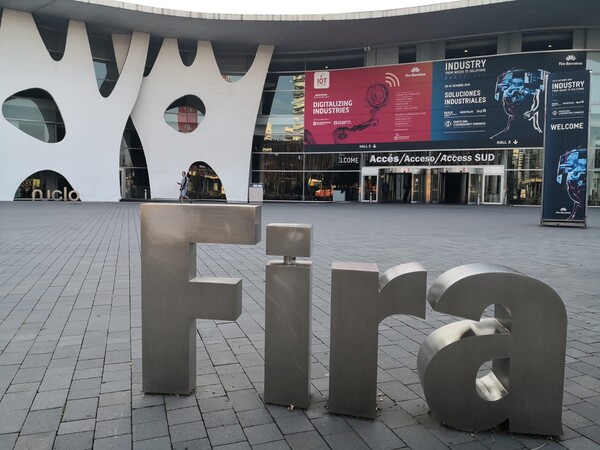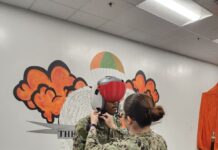In the first part of our coverage of the INDUSTRY event, we caught up with Miquel Serrano, Director of the show, who told us more about the new vision he had for the event. With regards to this fourth edition, and the addition of the machines-tools area in particular, Serrano explained that they added this segment to attract users of the machines-tool segment in the additive manufacturing arena. As said in the interview, his explanations seemed logical and justified, but we wanted to know if that decision was really efficient for the AM companies that were exhibiting this year. We have therefore decided to verify the efficiency of this strategy by asking them how the exhibition was to them and if they have been able to benefit from the machines-tools area’s visitors.

Renishaw
Our first conversation was with Andrea Valdivieso, Marketing Executive at Renishaw Ibérica. When asked if it was a good idea to integrate the machines-tools area in this edition, Valdivieso said:
“First, it should be noted that the show will welcome the machines-tools area every two years. Our opinion might be a little be biased as Renishaw specializes in several sectors of activities and some of these activities also include a close relation with the machines-tools industry. Today for instance, even though we showcase a wide range of AM applications, we also display our metrology products. In this sense, if we had to rate the number of visitors with regards to their interest, I would say, 50% of our visitors came for AM and 50% came for the other part of services we provide.”
HP
 HP Marketing Manager Iberia, Monica Colomé welcomed us on their booth at INDUSTRY. Unlike Renishaw, HP exclusively showcased their 3D printing solutions, and Colomé has been able to see a blatant difference compared to last year’s edition:
HP Marketing Manager Iberia, Monica Colomé welcomed us on their booth at INDUSTRY. Unlike Renishaw, HP exclusively showcased their 3D printing solutions, and Colomé has been able to see a blatant difference compared to last year’s edition:
“It’s difficult to find people that think in 3D. We have noticed that more people came for conventional manufacturing processes and after their visit of the show, started to see AM as an option in terms of production. For HP, it’s clear, there is a slight evolution in terms of penetration, but both technologies need to be next to each other in order to enable AM to evolve.”
For Colomé, there is still a certain fear among users that consider AM as a futuristic technology for now. Placing AM next to conventional manufacturing processes, it’s giving a chance to the user to compare and understand AM; most importantly to realize that AM is not that scaring.
SICNOVA

SICNOVA is a Spain-based distributor of 3D printing solutions. The group only supplies well-acknowledged brands of the industry. The group also develops and commercializes its own brand of industrial 3D printers named JCR. As a distributor, the group mainly operates in LATAM, Spain & Portugal. We caught up with Daniel Avila, Inside Sales Specialist and José Manuel Sanchez, Channel Development Manager of the company.
Both experts from the Spanish market strongly believe that “the addition of the machines-tools area makes more sense for the road towards industrialization”. Indeed, while comparing their presence last year in the show and the fourth edition of the exhibition, the specialists from Sicnova said that this edition of INDUSTRY was way better than last year. Indeed, “today, 50% of people think AM is for the future and they are not ready to invest in the technology now. That’s the reason why, we focus on education. Teaching people through AM use cases is the best way to show what the technology can do. Moreover, since the show will now move every two years from INDUSTRY to IN(3D)USTRY, it will easily enable people to feel more comfortable with the technology.”
Rösler

One company that also focuses on education is Rösler. With the recent launch of their AM brand, AM Solutions, the post-processing specialist is more than determined to foster the integration of AM within various industries. Frances Colom, R&D specialist, depicts the fact that, although the technology is still as its infancy in Spain, Rösler is investing a lot to encourage its adoption.
If the 3D printing technology itself is seen as a futuristic technology, the post-processing area is a fascinating world for Spanish professionals. Having their industrial post-processing system on the show, has raised questions on the importance and the utilization of post-processing solutions and the different steps (blasting, polishing and deep polishing) to achieve to reach the desired surface of the 3D printed part.
Sisma

What we found interesting when we met Sisma is that we discussed with two outsiders to the Spanish market: Albert Ventayol and Marco Giuseppe Andreetta. It was interesting to get their point of view on this show and the vision they have for both the Spanish and Italian markets.
It was the second time Sisma was exhibiting at INDUSTRY, and unlike Renishaw and HP that saw the nascent interest from visitors of the machines – tools area in additive manufacturing, our two resource persons said 70 % of people that came to their booth were directly interested in AM.
It should be noted that Sisma showcased two interesting products : their powder-bed, “Laser Metal Fusion” technology, and a “Digital Light Processing” system, whose oval shape is very eye-catching. Both platforms can be used for industrial, jewelry and medical applications.
While comparing the Spanish & the Italian AM markets, Andreetta said: “when it comes to AM, the Spanish market seems to focus on tooling whereas Italian users are mostly interested in fashion and jewellery. Moreover, we may find 80% of dental applications in Spain and only 20% of industrial applications, which is not really the case for Italy. The Italian market is also a nascent market but I believe, with the right technology, we will get there.”
Other companies like ARRK Europe Ltd also gave us a positive feedback from their presence on the show.
To sum up, exhibiting companies were globally satisfied with this fourth edition of INDUSTRY. The integration of the machines-tools area seems to be a great addition to the show. However, we also talked to a few other professionals whose expectations were not really met in terms of leads.
Those professionals wanted to remain anonymous regarding their feedback. However, after careful consideration, we realized that these professionals are also used to exhibit in biggest industry events. The truth is, if those professionals compared the Spanish market to the French, the UK or even the German markets where they meet advanced users of AM, there is a high probability that they came back from INDUSTRY a little bit disappointed. Not to mention that the Spanish business market remains a region where professionals keep a strong attachment to their language.
With regards to this edition of INDUSTRY, AM companies need to recognize that the Spanish market is moving slowly, but surely.
Interview conducted by Laura Depret & Kety Sindze. All pictures by Laura Depret from 3D ADEPT Media.
You can now post free of charge job opportunities in the AM Industry on 3D ADEPT Media. For further information about 3D Printing, follow us on our social networks and subscribe to our newsletter : Facebook, Twitter, LinkedIn & Instagram !Would you like to be featured in the next issue of our digital magazine? Send us an email at contact@3dadept.com






